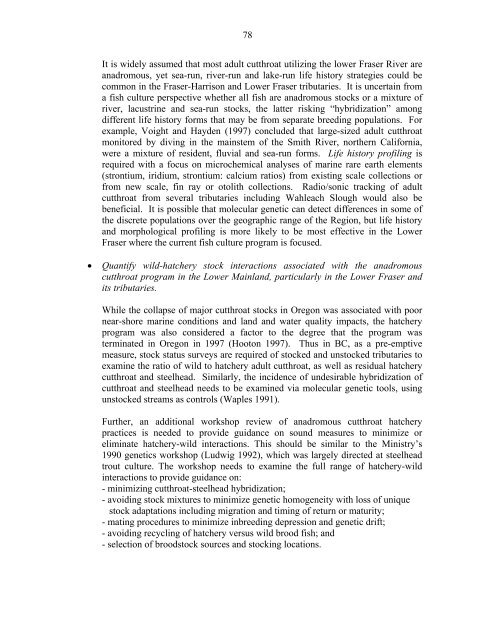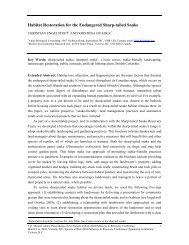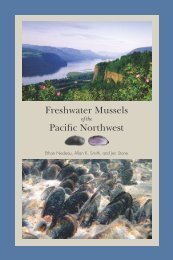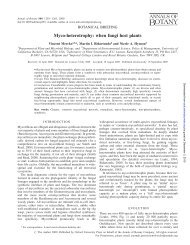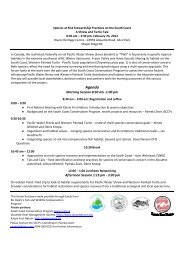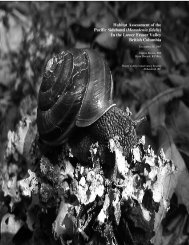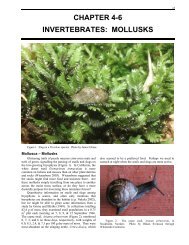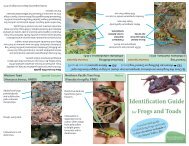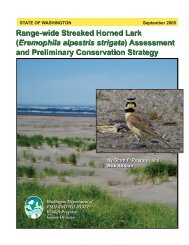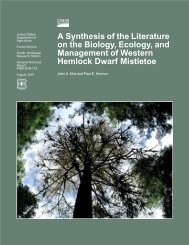Coastal Cutthroat Trout as Sentinels of Lower Mainland Watershed ...
Coastal Cutthroat Trout as Sentinels of Lower Mainland Watershed ...
Coastal Cutthroat Trout as Sentinels of Lower Mainland Watershed ...
You also want an ePaper? Increase the reach of your titles
YUMPU automatically turns print PDFs into web optimized ePapers that Google loves.
78It is widely <strong>as</strong>sumed that most adult cutthroat utilizing the lower Fr<strong>as</strong>er River areanadromous, yet sea-run, river-run and lake-run life history strategies could becommon in the Fr<strong>as</strong>er-Harrison and <strong>Lower</strong> Fr<strong>as</strong>er tributaries. It is uncertain froma fish culture perspective whether all fish are anadromous stocks or a mixture <strong>of</strong>river, lacustrine and sea-run stocks, the latter risking “hybridization” amongdifferent life history forms that may be from separate breeding populations. Forexample, Voight and Hayden (1997) concluded that large-sized adult cutthroatmonitored by diving in the mainstem <strong>of</strong> the Smith River, northern California,were a mixture <strong>of</strong> resident, fluvial and sea-run forms. Life history pr<strong>of</strong>iling isrequired with a focus on microchemical analyses <strong>of</strong> marine rare earth elements(strontium, iridium, strontium: calcium ratios) from existing scale collections orfrom new scale, fin ray or otolith collections. Radio/sonic tracking <strong>of</strong> adultcutthroat from several tributaries including Wahleach Slough would also bebeneficial. It is possible that molecular genetic can detect differences in some <strong>of</strong>the discrete populations over the geographic range <strong>of</strong> the Region, but life historyand morphological pr<strong>of</strong>iling is more likely to be most effective in the <strong>Lower</strong>Fr<strong>as</strong>er where the current fish culture program is focused.• Quantify wild-hatchery stock interactions <strong>as</strong>sociated with the anadromouscutthroat program in the <strong>Lower</strong> <strong>Mainland</strong>, particularly in the <strong>Lower</strong> Fr<strong>as</strong>er andits tributaries.While the collapse <strong>of</strong> major cutthroat stocks in Oregon w<strong>as</strong> <strong>as</strong>sociated with poornear-shore marine conditions and land and water quality impacts, the hatcheryprogram w<strong>as</strong> also considered a factor to the degree that the program w<strong>as</strong>terminated in Oregon in 1997 (Hooton 1997). Thus in BC, <strong>as</strong> a pre-emptiveme<strong>as</strong>ure, stock status surveys are required <strong>of</strong> stocked and unstocked tributaries toexamine the ratio <strong>of</strong> wild to hatchery adult cutthroat, <strong>as</strong> well <strong>as</strong> residual hatcherycutthroat and steelhead. Similarly, the incidence <strong>of</strong> undesirable hybridization <strong>of</strong>cutthroat and steelhead needs to be examined via molecular genetic tools, usingunstocked streams <strong>as</strong> controls (Waples 1991).Further, an additional workshop review <strong>of</strong> anadromous cutthroat hatcherypractices is needed to provide guidance on sound me<strong>as</strong>ures to minimize oreliminate hatchery-wild interactions. This should be similar to the Ministry’s1990 genetics workshop (Ludwig 1992), which w<strong>as</strong> largely directed at steelheadtrout culture. The workshop needs to examine the full range <strong>of</strong> hatchery-wildinteractions to provide guidance on:- minimizing cutthroat-steelhead hybridization;- avoiding stock mixtures to minimize genetic homogeneity with loss <strong>of</strong> uniquestock adaptations including migration and timing <strong>of</strong> return or maturity;- mating procedures to minimize inbreeding depression and genetic drift;- avoiding recycling <strong>of</strong> hatchery versus wild brood fish; and- selection <strong>of</strong> broodstock sources and stocking locations.


